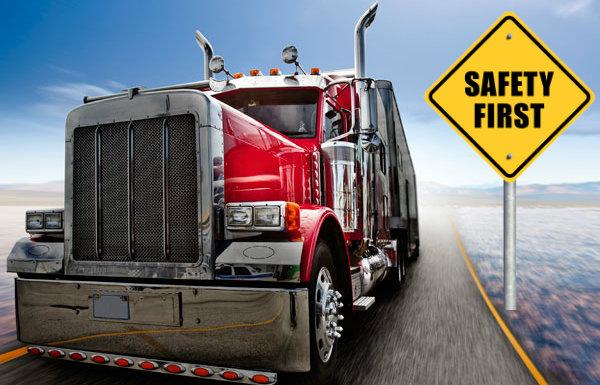Truck driver safety, while crucial for the well-being and security of truck drivers on the road, also involves coordination with truck dispatch services. These services play a pivotal role in ensuring that drivers receive necessary support and guidance to navigate safely through their routes. From providing real-time updates on road conditions to assisting with route planning and emergency response, truck dispatch services serve as invaluable allies in promoting safety and efficiency in the trucking industry. By integrating seamlessly with truck dispatch services, drivers can access vital information and resources that enhance their ability to make informed decisions and prioritize safety at all times.
What is Trucking Safety

At its core, truck driver safety revolves around minimizing risks and hazards that drivers may encounter during their journeys, thereby preventing accidents, injuries, and fatalities. This involves equipping drivers with the knowledge, skills, and resources necessary to navigate the challenges of the road safely and responsibly.
Truck driver safety encompasses a wide range of considerations, including:
- Safe Driving Practices: Following speed limits, maintaining a safe following distance, avoiding distractions, and staying alert and well-rested are fundamental aspects of safe driving for truck drivers.
- Vehicle Maintenance: Regular inspections, maintenance, and repairs are essential to ensure that trucks are in optimal condition for safe operation. This includes checking brakes, tires, lights, and other critical components.
- Cargo Management: Properly securing and distributing cargo is crucial to maintaining vehicle stability and preventing accidents caused by shifting loads or unbalanced weight distribution.
- Adherence to Regulations: Truck drivers must comply with various regulations and guidelines set forth by regulatory authorities to ensure safety on the road. This includes regulations related to hours of service, driver qualifications, and vehicle specifications.
- Weather and Road Conditions: Being aware of and prepared for adverse weather conditions and challenging road conditions is vital for safe truck driving. Drivers should adjust their driving behavior and take appropriate precautions to mitigate risks.
- Emergency Preparedness: Having knowledge of emergency procedures and being equipped with necessary safety equipment, such as first aid kits and emergency contact information, can help drivers respond effectively to unforeseen situations.
Overall, truck driver safety is a multifaceted concept that requires ongoing attention, training, and commitment from drivers, employers, regulatory agencies, and other stakeholders in the trucking industry. By prioritizing safety and implementing best practices, truck drivers can help ensure their own well-being and the safety of everyone sharing the road with them.
10 Truck Driver Safety Tips
Truck driver safety tips are practical guidelines and strategies aimed at minimizing risks and promoting safe practices for truck drivers while they navigate roads and highways. These tips are designed to enhance awareness, preparedness, and responsible behavior behind the wheel, ultimately reducing the likelihood of accidents and ensuring the well-being of drivers and other road users. Here are some essential truck driver safety tips:
- Maintain a Safe Following Distance: Allow ample space between your truck and the vehicle in front of you to provide enough time to react and stop safely if needed. The recommended following distance is typically several seconds, depending on road conditions and speed.
- Observe Speed Limits: Adhere to posted speed limits and adjust your speed according to road conditions, traffic flow, and weather. Driving at a safe speed reduces the risk of accidents and gives you more time to react to unexpected situations.
- Avoid Distractions: Minimize distractions such as using mobile phones, eating, drinking, or adjusting the radio while driving. Keep your focus on the road at all times to maintain situational awareness and react quickly to changing conditions.
- Stay Alert and Well-Rested: Get an adequate amount of sleep before starting a trip, and take regular breaks to rest and recharge during long hauls. Fatigue impairs judgment and reaction time, increasing the risk of accidents. Listen to your body and pull over if you feel drowsy.
- Use Proper Ergonomics: Adjust your seat, steering wheel, and mirrors to ensure proper posture and visibility while driving. Maintain a comfortable driving position to reduce fatigue and prevent musculoskeletal injuries.
- Inspect Your Vehicle Regularly: Conduct pre-trip inspections to check for any mechanical issues, tire damage, or fluid leaks. Address any problems promptly to ensure your vehicle is in safe working condition before hitting the road.
- Secure Your Cargo Properly: Properly secure your cargo using appropriate tie-downs, straps, and fasteners to prevent shifting or falling during transit. Distribute the load evenly and within the weight limits specified for your vehicle.
- Plan Your Route: Familiarize yourself with your route in advance, including potential hazards such as construction zones, low bridges, or steep grades. Use GPS navigation systems or maps to plan alternate routes if needed and avoid unexpected delays or obstacles.
- Maintain Distance in Inclement Weather: Increase your following distance and reduce your speed when driving in adverse weather conditions such as rain, snow, or fog. Be prepared for reduced visibility and slippery road surfaces, and use caution when braking or maneuvering.
- Practice Defensive Driving: Anticipate the actions of other drivers and be prepared to react defensively to avoid accidents. Stay aware of your surroundings, use your mirrors effectively, and signal your intentions clearly to communicate with other road users.
By following these truck driver safety tips and incorporating them into your daily routine, you can help ensure a safer and more enjoyable driving experience for yourself and others on the road. Remember, safety should always be your top priority as a professional truck driver.
We also need to advise you owner operator truck driver jobs from our company, we will inform you about safe truck driving and take most of the work, and you will drive under our MC number and have many orders
Safety Messages for Truck Drivers

Safety messages for truck drivers are concise, impactful statements or reminders aimed at promoting awareness, responsibility, and adherence to safe driving practices. These messages are often displayed in trucking terminals, rest areas, company facilities, or shared through various communication channels to reinforce a culture of safety within the trucking industry. Here are some examples of safety messages for truck drivers:
- "Safety First, Always."
- "Buckle Up, Every Trip, Every Time."
- "Stay Alert, Stay Alive."
- "Don't Text and Drive. It Can Wait."
- "Keep Your Eyes on the Road, Not on Your Phone."
- "Take Regular Breaks to Stay Fresh and Alert."
- "Slow Down, Arrive Alive."
- "Check Your Blind Spots Before Changing Lanes."
- "Avoid Tailgating. Leave Plenty of Space."
- "Inspect Your Vehicle Before Every Trip."
- "Secure Your Load. Safety Starts with Proper Cargo Management."
- "Watch for Pedestrians and Cyclists. Share the Road Safely."
- "Plan Your Route and Know Your Surroundings."
- "Drive Defensively. Anticipate, React, and Stay Safe."
- "Report Unsafe Conditions or Hazards Immediately."
- "Never Drive Under the Influence of Alcohol or Drugs."
- "Use Your Signals. Let Others Know Your Intentions."
- "Stay Calm and Patient in Traffic. Safety Comes First."
- "Weather the Weather: Adjust Your Driving for Conditions."
- "Protect Yourself and Others: Wear Your Seatbelt."
These safety messages serve as constant reminders for truck drivers to prioritize safety, maintain vigilance, and uphold their responsibility to themselves and others on the road. By internalizing and acting upon these messages, truck drivers can contribute to safer roads and reduce the risk of accidents and injuries in the trucking industry.
Truck Driver Safety Topics

Truck driver safety topics encompass a wide range of subjects related to ensuring the well-being of truck drivers and promoting safe practices on the road. These topics address various aspects of driving, vehicle maintenance, regulatory compliance, and personal health and well-being. Here are some truck driver safety topics that are essential for promoting a culture of safety within the trucking industry:
- Safe Driving Practices: Discussing safe driving practices such as maintaining a safe following distance, obeying speed limits, avoiding distractions, and practicing defensive driving techniques.
- Vehicle Inspection and Maintenance: Highlighting the importance of regular vehicle inspections, maintenance, and repairs to ensure that trucks are in safe operating condition.
- Cargo Securement: Explaining proper cargo securement techniques to prevent shifting or falling loads, which can pose hazards to drivers and other road users.
- Fatigue Management: Addressing the risks of driver fatigue and the importance of getting adequate rest, taking breaks, and recognizing signs of fatigue to prevent accidents.
- Weather Preparedness: Providing guidance on navigating adverse weather conditions such as rain, snow, ice, or high winds, and adapting driving behavior accordingly.
- Emergency Response: Educating drivers on how to respond to emergencies such as accidents, breakdowns, hazardous spills, or medical emergencies effectively and safely.
- Regulatory Compliance: Ensuring drivers understand and comply with federal and state regulations governing hours of service, vehicle specifications, and other safety requirements.
- Health and Wellness: Promoting physical fitness, proper nutrition, and mental well-being to help drivers stay healthy, alert, and focused on the road.
- Drug and Alcohol Awareness: Educating drivers about the dangers of driving under the influence of drugs or alcohol and encouraging responsible behavior behind the wheel.
- Work Zone Safety: Highlighting the importance of caution and vigilance when driving through work zones, where construction activities and reduced speed limits are in effect.
- Intersection Safety: Discussing best practices for navigating intersections safely, including yielding to pedestrians, cyclists, and other vehicles, and using turn signals appropriately.
- Backing and Parking: Providing tips and techniques for safe backing maneuvers and parking procedures to minimize the risk of collisions and accidents.
- Load Securement: Detailing proper techniques for securing different types of cargo, including flatbed, dry van, or hazardous materials, to prevent load shifts and maintain vehicle stability.
- Communication Skills: Emphasizing the importance of clear communication with dispatchers, fellow drivers, and other road users to enhance safety and efficiency on the road.
- Continuous Learning and Improvement: Encouraging drivers to participate in ongoing training programs, safety meetings, and professional development opportunities to stay informed and enhance their skills as safe and responsible drivers.
By addressing these truck driver safety topics comprehensively, companies, regulators, and industry stakeholders can foster a culture of safety and equip drivers with the knowledge and resources needed to navigate the roads safely and responsibly.
Understanding Truck Safety
Trucking safety stands as a bastion of protection, encompassing an array of practices and protocols meticulously crafted to avert accidents and safeguard the lives of truck drivers and fellow travelers. Delving into the intricacies of truck driver safety unveils a tapestry of precautionary measures and proactive strategies that serve as bulwarks against potential hazards lurking on the highways and byways.
Prioritizing Safe Driving
At the heart of truck driver safety lies the unwavering commitment to safe driving practices. These cardinal principles serve as guiding beacons, illuminating the path to accident-free journeys and ensuring the well-being of all road users. Let us delve into the nuances of safe driving, unraveling the fabric of each tip to empower truck drivers with the knowledge and vigilance necessary for safe traversal.
Maintain a Safe Following Distance
The significance of maintaining a safe following distance cannot be overstated. By fostering a buffer zone between their vehicles and those ahead, truck drivers afford themselves precious moments to react swiftly to unforeseen circumstances, thereby mitigating the risks of rear-end collisions and promoting safe passage on the roads.
Observe Speed Limits
Adhering to speed limits serves as a linchpin in the framework of safe driving. By respecting the prescribed limits and exercising prudence in their velocity, truck drivers not only adhere to legal mandates but also enhance their ability to respond effectively to changing road conditions, thereby curbing the incidence of speed-related accidents.
Avoid Distractions
Distractions pose formidable threats to the safety of truck drivers and fellow road users alike. By steadfastly shunning distractions such as mobile devices, food consumption, and inattentive behaviors, drivers uphold their duty of care and ensure that their focus remains steadfastly fixed on the task at hand: navigating the roads safely and responsibly.
Stay Alert and Well-Rested
Vigilance and alertness serve as stalwart sentinels in the realm of safe driving. Recognizing the perils of driver fatigue, truck drivers prioritize adequate rest and respite, thereby fortifying themselves against the encroaching specter of drowsiness and safeguarding their ability to respond swiftly to emergent situations on the road.
Ensuring Vehicle Safety
The safety of a truck is a symbiotic amalgamation of meticulous maintenance practices and judicious cargo management. By attending to the health and integrity of their vehicles, truck drivers not only enhance their safety but also uphold their commitment to the welfare of all road users. Let us embark on a journey through the corridors of vehicle safety, uncovering the myriad strategies and techniques that underpin this cornerstone of safe trucking.
Regular Vehicle Inspections
Preemptive vigilance stands as the vanguard against mechanical maladies and potential hazards lurking within the bowels of a truck. Through regular and comprehensive inspections, drivers proactively identify and rectify issues before they metastasize into full-blown emergencies, thereby ensuring the reliability and safety of their vehicles on the road.
Proper Cargo Securement
Cargo, when improperly secured, poses an existential threat to the stability and safety of a truck. By meticulously adhering to prescribed protocols for cargo securement, drivers mitigate the risks of shifting loads and destabilization, thereby fostering a conducive environment for safe traversal and safeguarding the integrity of their cargo.
Brake Maintenance
The efficacy of a truck's brakes stands as a linchpin in its safety apparatus. Through diligent maintenance and periodic inspections, drivers fortify this critical component against wear and degradation, thereby preserving its responsiveness and ensuring optimal stopping power in moments of need.
Tire Maintenance
Tires serve as the literal interface between a truck and the road, underscoring their pivotal role in ensuring safe traversal. By meticulously attending to tire maintenance tasks such as pressure checks, tread inspections, and timely replacements, drivers fortify their vehicles against the perils of blowouts and loss of traction, thereby enhancing overall safety on the road.




